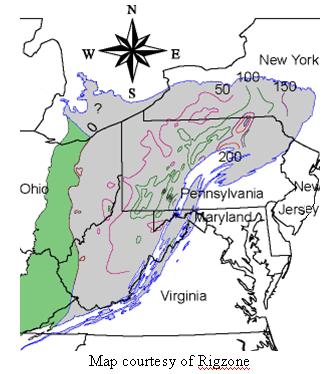Marcellus shale
From Wikimarcellus
| Revision as of 22:09, 23 October 2008 Tcopley (Talk | contribs) ← Previous diff |
Revision as of 22:11, 23 October 2008 Tcopley (Talk | contribs) Next diff → |
||
| Line 18: | Line 18: | ||
| These layers of rock have different organic contents as well as their own separate thickness characteristics due to the way in which the shale was originally deposited and over time eroded. | These layers of rock have different organic contents as well as their own separate thickness characteristics due to the way in which the shale was originally deposited and over time eroded. | ||
| - | It has been known for decades that this layer contained gas, but until recently it was not believed economical to extract. Recent improvements in technology such as [[horizontal drilling]] and [[hydro-fracturing|hydraulic fracturing]] of the shale have somewhat changed its economics. When these developments are combined with the comparatively high prices of natural gas during the first half of 2008 the endeavor appeared profitable for all of its participants. | + | It has been known for decades that this layer contained gas, but until recently it was not believed economical to extract. Recent improvements in technology such as [[horizontal drilling]] and [[hydro-fracturing|hydraulic fracturing]] of the shale have somewhat changed its economics. When these developments are combined with the comparatively high prices of natural gas during the first half of 2008 the endeavor appeared profitable for all of its participants. Now that prices have dipped under US $8 per MMBTU earning a reasonable return on investment may prove much more elusive. |
| Recent estimates indicate that there are 50 trillion cubic feet of recoverable natural gas in the Marcellus shale. This is twice the amount consumed during 2007 in the U.S. | Recent estimates indicate that there are 50 trillion cubic feet of recoverable natural gas in the Marcellus shale. This is twice the amount consumed during 2007 in the U.S. | ||
Revision as of 22:11, 23 October 2008
Here is where some info about the Marcellus shale formation should go. This article is still a stub and needs your attention. It does not have a template and contains minimal information. Please dive in and help it grow!
The Marcellus shale formation is a marine-sedimentary, rich-organic layer of black-shale rock found deep underground in an area stretching roughly 600 miles from southwestern New York to West Virginia and includes parts of Maryland, Kentucky, Ohio and Virginia. It is very high-quality source rock. The thickest portion of it is located in eastern Pennsylvania and southern New York with a thickness of 250 feet or more. The main area of the formation is around 18 million acres. It is named for an outcropping near Marcellus, N.Y.
Gas in the formation is found in pores of the rock so tight that it is released only very slowly or else the gas tightly adheres to the rock. Both conditions may be true.
The Marcellus shale has three main sub-divisions:
- Cherry Valley Limestone (differently named in various locations)
- Oatka Creek Shale
- Union Springs Shale
These layers of rock have different organic contents as well as their own separate thickness characteristics due to the way in which the shale was originally deposited and over time eroded.
It has been known for decades that this layer contained gas, but until recently it was not believed economical to extract. Recent improvements in technology such as horizontal drilling and hydraulic fracturing of the shale have somewhat changed its economics. When these developments are combined with the comparatively high prices of natural gas during the first half of 2008 the endeavor appeared profitable for all of its participants. Now that prices have dipped under US $8 per MMBTU earning a reasonable return on investment may prove much more elusive.
Recent estimates indicate that there are 50 trillion cubic feet of recoverable natural gas in the Marcellus shale. This is twice the amount consumed during 2007 in the U.S.
In some areas of the formation, natural gas fractions are also present such as butane, ethane, and propane.
Pennsylvania has around one half of the proven U.S. natural gas reserves. The proximity of most of the deposits to the natural gas consuming cities of the east coast make the Marcellus an especially attractive target for exploration.
The Marcellus shale formation is usually found at a depth of 5,000 to 8,000 feet, but can run as deep as 9,000 feet. Pressure gradients range between .40 to .58 psi.
The production of a typical shale gas well drops off significantly after the initial year or two and then slowly declines after that over its full lifetime.
In the industry, it is known as an “unconventional deposit.”
One method of prospecting for gas, not only in shale formations but also for gas found within deeper structures below, is to use seismic waves to map out the underground location of deposits.


